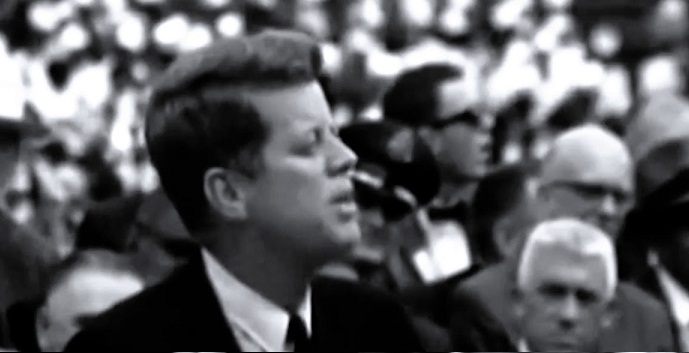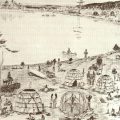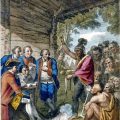Fifty years ago, the United States government was still focused on a program of terminating its relations with and obligations to any Indian nations. Treaties were seen as historic documents rather than legal agreements between sovereign nations. There was very little concern for Indian rights and a general feeling that Indians, like other immigrants to the United States, should assimilate into the stereotype of mainstream American culture. The government continued to transfer wealth in the form of resources from Indian reservations to corporations.

President John F. Kennedy:
In Washington, D.C., the leadership of the National Congress of American Indians (NCAI) met with President John F. Kennedy. Jacqueline Kennedy then invited the delegates to return the following day when they were given a tour of the White House. The delegates, dressed in traditional regalia, performed Indian dances for Caroline, John Jr., and other children at the White House school.
Water and Mineral Rights:
In Arizona versus California I the Supreme Court reaffirms the Winters Doctrine and earlier Indian water rights cases by granting five lower Colorado River tribes sufficient irrigation water. According to the Court:
“In our view, these reservations, like those created directly by Congress, were not limited to land, but included waters as well.”
In addition, the Court found that the quantity of water reserved for the tribes must be enough to satisfy the future needs of the Indians. This meant that tribal water rights were to be defined by the amount of land that could be watered by modern technology, not by the techniques available when the reservation was established.
In Arizona, the San Carlos Apache asked that the subsurface rights for the area known as the Mineral Strip be restored to them. They noted that there was opposition to the restoration of the surface rights. The Department of the Interior restored the subsurface rights, noting that this would allow the tribe to develop the mineral potential of the area.
Fishing Rights:
In Washington, rangers from the Olympic National Park burned down a Makah smokehouse and canning structure at the mouth of the Ozette River. The tribal council protested the action as a violation of their 1855 treaty.
In Oregon, the Confederated Tribes of the Umatilla Reservation filed suit against the Oregon State Police and the State of Oregon. The tribes asked for a judgment that the state restrictions on salmon and steelhead fishing do not apply to Indians. They also asked for an injunction to keep the state from enforcing their restrictions against tribal members. The Ninth Circuit Court of Appeals declared that the state could not impose its rules on the Indians unless those rules were clearly indispensible to fish conservation. According to the Court, the State had not even come close to showing such a need. The ruling was considered a major victory for the tribes as it impeded the states’ efforts to place a disproportionate share of the conservation burden on Indians.
Sacred Sites:
With the completion of Glen Canyon Dam and Lake Powell in northern Arizona, the once remote Rainbow Natural Bridge National Monument, a sacred place for the Navajo, became more accessible. The National Park Service provided a boat and dock service for tourists.
In Oregon, Fort Rock Cave was dedicated as a National Historic Landmark. Fort Rock Cave is among the oldest prehistoric sites in the northern Great Basin.
In Massachusetts, Dighton Rock, an ancient petroglyph site, was moved and protected with a coffer dam.
In Idaho, the Cataldo Mission, a Jesuit mission among the Coeur d’Alene, was designated by the National Park Service as a Registered National Historic Landmark.
In California, the state legislature recognizes that California Indian culture was neither sufficiently understood nor adequately chronicled. However, no action was taken other than a request that archaeological sites be reported to the Department of Parks and Recreation.
Racism:
South Dakota enacted a law which gave the state civil and criminal jurisdiction on reservations. Despite the high Native population in the state, there were no Sioux representatives in the legislature and the Sioux clearly opposed the notion. In signing the new law, the state governor stressed equal rights in the manner of politicians who advocated the termination of Indian reservations:
“We’ll be giving the Indian equal protection under the law. We hear a lot about civil rights. But until all South Dakotans are treated the same, we’ll never achieve the full potential of our state.”
In response to the new law a new organization – United Sioux Tribes – was formed and a petition drive was started to allow state voters to vote on the issue. In two months they gathered the 14,000 signatures necessary to have the matter considered on a public referendum. In their campaign, the Sioux focused on the voters’ sense of fairness: the state law was wrong simply because the Sioux never consented to it. The referendum passed with 79% of the vote and the law was thus overturned.
In Louisiana, the Houma in Margie Willa Naquin, et al v. Terrebonne Board of Education won a court order mandating school desegregation.
Land Claims:
The Indian Claims Commission awarded California Indians an additional $29 million for lands taken from them.
The Indian Claims Commission and the Bureau of Indian Affairs (BIA) reached a compromise agreement to include the Pit River Indian land claim in with the general California Indian land claim. This compromise was rejected by the Pit River Indians. In a referendum conducted by the BIA, the Pit River Indians voted against the compromise. In response, the BIA conducted an absentee ballot which resulted in a 24 vote margin in favor of the compromise.
The Indian Claims Commission awarded $3 million to the Kalispel in Washington state. However, before the money could be awarded, the Kalispel were required to come up with a plan for spending the money. When the Kalispel put forward a plan to use the money for youth development, a community building, housing, and industrial development, acceptance of the plan was stalled in Congress because the plan did not call for the termination of the reservation.
In Washington, D.C., a bill was introduced in Congress which would provide the conveyance of federal lands to the Pascua Yaqui Association (PYA) in Arizona for the purpose of preserving and enhancing Yaqui culture. The bill called for 200 acres of Bureau of Land Management land to be deeded to the PYA. The bill was opposed by termination-minded officials in Washington, D.C.
In South Dakota, the federal government declared land taken from the Oglala Sioux on the Pine Ridge Reservation to be used as a bombing range during World War II to be surplus. While the government no longer needed the land, they did not return it to the tribe.
Dam Indians:
Congress took up consideration of House Resolution 1794 regarding the relocation of the Seneca caused by the construction of Kinzua Dam. The Pennsylvania Railroad had received the final payment of its twenty million dollars to relocate railroad tracks six months before Congress began to concern itself with the Seneca.
In New York, the Seneca had to remove 42 graveyards which were to be flooded by Kinzua Dam. Two new cemeteries were established for the estimated 3,000 graves.
In Oregon, the Corps of Engineers completed work on the Cascade Locks in-lieu fishing site for the Mid-Columbia tribes. This was the fifth of the six sites which had been promised to the tribes when Bonneville Dam was constructed. The Corps still had $40,000 left in the in-lieu fishing site budget, but it had no prospects for the sixth site and the 360 additional acres which had been promised to the tribes.
Tribal Government:
In Florida, the Seminole adopted a Bill of Rights which included religious freedom. Under this provision, the tribal council was forbidden to interfere with traditional religious practices. The new Bill of Rights recognized that a significant number of Seminoles still held traditional religious beliefs and there was a fear of the possibility of religious persecution from the growth of Christian influence on the reservations. In some areas Baptist congregations had already forced the traditional Green Corn Dance off the reservation and there was talk about a religious test (Christian) for participation in tribal government.
In Wisconsin, the Winnebago reluctantly reorganized according to the guidelines of the 1934 Indian Reorganization Act. They retained their chief-clan structure which is based on four Sky clans and eight Earth clans.
Termination:
In Wisconsin, 800 Menominee adults-a majority of the tribe’s adults-signed a petition asking the federal government to end the termination of the tribe. The federal government ignored the petition.
Book:
Book of the Hopi, by Frank Waters, was published. This is considered to be a pioneer of New Age Indianism and had a great deal of influence over the counterculture of the 1960s and 1970s. The new book built upon earlier themes to represent mystical Indians as the prophets both of imminent crises and of the eventual coming of a glorious era, the ‘New Age.’ The book pretends to be the collective voice of thirty Hopi elders rather than the work of a single non-Indian author. This book can be seen as laying the foundation for New Age spirituality among non-Indians.
Art, History, Tourism:
In New York City, the Association of American Indian Affairs established the New York City American Indian Arts Center to exhibit and sell art by Indian artists.
In Colorado, the Southern Ute purchased Lake Capote and opened it to the public for fishing. This new business was intended to increase tourism on the reservation.
The Cherokee National Historical Society was founded.




Leave a Reply